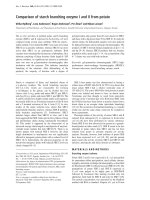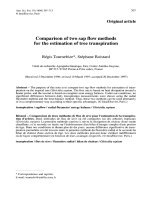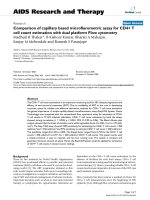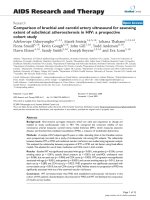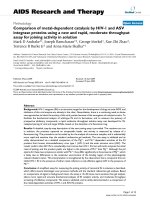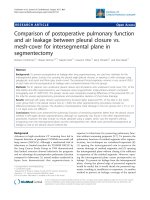Báo cáo y học: "Comparison of two protective lung ventilatory regimes on oxygenation during one-lung ventilation: a randomized controlled trial" pps
Bạn đang xem bản rút gọn của tài liệu. Xem và tải ngay bản đầy đủ của tài liệu tại đây (422.59 KB, 5 trang )
RESEARC H ARTIC L E Open Access
Comparison of two protective lung ventilatory
regimes on oxygenation during one-lung
ventilation: a randomized controlled trial
Félix R Montes
1*
, Daniel F Pardo
1
, Hernán Charrís
1
, Luis J Tellez
2
, Juan C Garzón
2
, Camilo Osorio
2
Abstract
Background: The efficacy of protective ventilation in acute lung injury has validated its use in the operating room
for patients undergoing thoracic surgery with one-lung ventilation (OLV). The purpose of this study was to
investigate the effects of two different modes of ventilation using low tidal volumes: pressure controlled ventilation
(PCV) vs. volume controlled ventilation (VCV) on oxygenation and airway pressures during OLV.
Methods: We studied 41 patients scheduled for thoracoscopy surgery. After initial two-lung ventilation with VCV
patients were randomly assigned to one of two groups. In one group OLV was started with VCV (tidal volume
6 mL/kg, PEEP 5) and after 30 minutes ventilation was switched to PCV (inspiratory pressure to provide a tidal
volume of 6 mL/kg, PEEP 5) for the same time period. In the second group, ventilation modes were performed in
reverse order. Airway pressures and blood gases were obtained at the end of each ventilatory mode.
Results: PaO
2
, PaCO
2
and alveolar-arterial oxygen difference did not differ between PCV and VCV. Peak airway
pressure was significantly lower in PCV compared with VCV (19.9 ± 3.8 cmH
2
O vs 23.1 ± 4.3 cmH
2
O; p < 0.001)
without any significant differences in mean and plateau pressures.
Conclusions: In patients with good preoperative pulmonary function undergoing thoracoscopy surgery, the use of
a protective lung ventilation strategy with VCV or PCV does not affect the oxygenation. PCV was associated with
lower peak airway pressures.
Introduction
Anesthesia for thoracic surgery rout inely involves one
lung ventilation (OLV) to provide optimum surgical
oper ating conditions and to isolate and protect the lungs
during the procedure. Unfortunately, this practice may
associate with an importan t impairment in gas exchange,
particularly in patients with previous lung disease [1].
OLV traditionally has been performed with tidal
volumes (V
T
) that are equal to those being used on two
lung ventilation (TLV) [2]. Over the past decades, V
T
used
by clinicians have progressively decreased from more than
12-15 ml/kg to less than 9 ml/kg actual body weight [3-6].
This practice is based on several studies that showed that
mechanical ventilation using V
T
of no more than 6 ml/kg
resulted in reduction of systemic inflammatory markers,
increased ventilator-free days, and reduction in mortality
when compared with V
T
of 12 ml/kg in patients with
acute lung injury (ALI) and acute respiratory stress syn-
drome [7,8]. The reduction of V
T
has been recommended
in patients without pulmonary pathology at the onset of
mechanical ventilation [9].
The use of l ow V
T
has been also recommended in
patients during OLV [10]. Recent studies have suggested
that low V
T
during OLV can be associated with a
decreased incidence of complications [11-13]. However
the effects of low V
T
on oxygenation in patients under-
going thoracic surgery with OLV have been less examined.
In the operating room, volume controlled ventilation
(VCV) is commonly used and it has become the dominant
ventilator mode. However, the mechanical characteristics
of pressure controlled ventilation (PVC) are thought to
allow more homogeneous distribution of ventilation and
improved ventilation-perfusion matching [14]. The aim of
this study is to evaluate the impact of two currently used
* Correspondence:
1
Department of Anesthesiology. Fundación CardioInfantil - Instituto de
Cardiología. Calle 163 A # 13B - 60. Bogotá, Colombia, South América
Full list of author information is available at the end of the article
Montes et al. Journal of Cardiothoracic Surgery 2010, 5:99
/>© 2010 Montes et al; licensee BioMed Central Ltd. This is an Open Access article distributed under t he terms of the Creative Com mons
Attribution License ( 2.0), which permits unrestricted use, distribution, and reproduction in
any medium, provided the original work is properly cited.
protective lung ventilation strategies on oxygenation dur-
ing OLV in patients undergoing thoracic surgery.
Patients and Methods
After approval by the Fundación Cardio Infantil-Instituto
de Cardiología ethics committee and after obtaining writ-
ten informed consent from each individual, we enrolled
into the study 41 patients undergoing elective thoracic
surgery requiring at least 1 hour of OLV. All patients
were ASA p hysical status I-III and aged between 18 and
75 years. Pa tients with a documented history of uncom-
pensated cardiac, hepatic o renal disease were excluded
from the study. All patients underwent arterial blood
gases and lung spirometry prior to surgery.
Upon arrival to the operating room, patients were
monitored with electrocardi ogram and SpO
2
. A 14-gauge
IV catheter was inserted in an upper extremity vein and a
20-gauge catheter was inserted in a radial artery to per-
mit continuous recording of arterial pressure. After pre-
oxygenation, anesthesia was induced with remifentanil
0.2 μg/kg/min, propofol 2 mg/kg, and cisatracurium 0.15
mg/kg. Anesthesia was maintained with a continuous
infusi on of remifentanil 0.1 μg/kg/min, propofol 100 μg/
kg/min, and supplemental cisatracurium. Clinical signs of
light anesthesia characterized by hemodynamic responses
to surgical stimulation [median arterial blood pressure
(MAP) > 20% of the preinduction baseline values and/or
heart rate (HR) > 90 bpm], somatic (patient movement,
eye opening) or autonomic (lacrimation, sweating)
responses were treated with boluses of remifentanil 0.5
μg/kg followed by 50% increments in the infusion rate. A
minimum time of 1 minute w as required between infu-
sion rate increases. Excessive depth of anesthesia judged
by hypotension (MAP < 20% of the preinduction base-
line) and/or bradycardia (HR < 40 bpm) was treated by a
50% decrement in the remifentanil infusion rate. If this
treatment proved inadequate, IV etilefrine (for hypoten-
sion) or atropine (for bradycardia) was administered. The
propofol infusion was un changed. No volatile anesthetics
were used. The trachea was intubated with a double
lumen tube (Mallinckrodt-BroncoCath, Tyco Health
Care, Pleasanton, CA) no. 37 for male and no. 35 for
fem ale patie nts. Left doub le-lumen tubes were chosen as
long as there was no contraindication. The position of
the tube was confirmed by auscultation and fiberoptic
bronchoscopy before and after turning the patient to the
lateral decubitus position.
Initially, TLV with VCV was performed in all
patients using a FIO
2
of 1.0, a V
T
of 9 mL/kg, and a
ventilator rate of 12/min, then adjusted to maintain
end-tidal carbon dioxide tension (E
T
CO
2
)of25to30
mmHg (Servo 900C; Siemens, Solna, Sweden) [Normal
arterial oxygen and carbon dioxide tension in Bogota
are 60 ± 3 and 30 ± 3 mm Hg respectively (8700 ft or
2600 m above sea level)]. The inspiratory time and the
end-inspiratory pause time were adjusted as 25% and
10% respectively, and it was unchanged during all the
study. No external positive end expiratory pressure
(PEEP) was applied during this period. Prior initiation
of OLV, patients were randomly assigned, according to
a computer-generated random number table, to one of
two groups. Group A: OLV was started by VCV (OLV-
VCV) using a V
T
of6mL/kg,PEEPof5cmH
2
O, and
the ventilator rate adjusted t o maintain a E
T
CO
2
of 25
to 30 mmHg. After 30 min PCV (decelerating inspira-
tory flow) was started with a FIO
2
of 1.0, P EEP of 5
cm H
2
O, a peak airway pressure adjusted to obtain the
same V
T
as during VCV, and a ventilator frequency
adjusted to keep E
T
CO
2
of 25 to 30 mmHg. Group B:
PCV was initiated with a peak airway pressure that
provided a V
T
of6mL/kg,PEEPof5cmH
2
O, and a
ventilator rate adjusted to maintain E
T
CO
2
of 25 to 30
mmHg. After 30 min the ventilator was changed to
VCV with a V
T
6mL/kg,PEEPof5cmH
2
O, and the
ventilator frequency adjusted to maintain a E
T
CO
2
of
25 to 30 mmHg.
Blood gas analysis, hemodynamic measurements, peak
inspiratory pressure (Ppeak), mean inpiratory (Pmean),
plateau inspiratory pressure (Pplateau), and expired V
T
were measured and recorded at four stages: (1) During
TLV using VCV prior the beginning of OLV; (2) During
OLV 30 min after initiat ion of the first ventilation
mod e; (3) During OLV 30 min after the second ventila-
tor mode; and (4) End of surgery: 30 min after reestab-
lishing TLV with VCV. During the measurement period
surgical manipulation of the lung was not allowed.
A power analysis based on a previous study [15]
revealed a total sample size of 38 patients was required
to achieve a power of 80% and an a of 0.05 for detec-
tion of 40 mmHg difference in the PaO
2
value. Student’s
t test and ANOVA were used to determine the signifi-
cance of normally distributed parametric values. Catego-
rical variables were tested using c2 test or, when
appropriate, Fisher’s exact t est. Statistical significance
was accepted at p < 0.05.
Results
Forty-one patients were enrolled into the study. There
were no significant differences between the two groups
in demographic characteristics, type of surgical proce-
dure performed or pre-operative lung function test
(table 1). No patient was excluded from the study due
to any preoperative o intraoperative criteria, and in all
patients left-double lumen tubes were used.
The beginning of OLV with either VCV or PCV pro-
duced a significant increase in mean (p < 0.001), and
plateau (p < 0.01) airway pressures; the Ppeak was signifi-
cantly higher in VCV patients (p = 0.001) but not in PCV
Montes et al. Journal of Cardiothoracic Surgery 2010, 5:99
/>Page 2 of 5
patients (p = 0.53) compared with the initial TLV. As
expected, the PaO
2
with any mode of OLV was signifi-
cant ly lower compared to TLV (p < 0.001) and increased
to a similar level after switch ing again to TLV. Compari-
son of the OLV-VCV and OLV-PCV showed a significant
difference in Ppeak (p = 0.003) without differences in
Pmean, Pplateau PaO
2
,andPaCO
2
, (Table 2). The
sequence of OLV did not influence the airway pressures
or blood gases values.
Discussion
The ventilator strat egy recommended to reduce the inci-
dence of ALI in patients undergoing thoracic surgery is
to use lower Vt (5-7 mL/kg) with moderate amounts of
PEEP (5-6 cmH
2
O) [10,16]. The present study suggests
that using any of the common available ventilator modes,
VCV or PCV with a “lung protective” approach, results
in similar effects on oxygenation and gas exchange.
VCV has been considered the traditional or conven-
tional approach to mechanical ventilation of patients
undergoing thoracic surgery and OLV. However, in
recent years PCV has gained renew interest due to its
potential advantages [2,17,18]. VCV uses a constant
inspired flow (square wave), creating a progressive
increase of airway p ressure toward the peak in spiratory
pressure, which is reached as the full tidal volume has
been delivered. Unlike VCV, PVC ventilator mode pro-
duce s appropriate flow to rapidly reach and maintain the
set inspiratory pressure (square pressure wavefo rm). The
resultant respiratory flow is usually decelerating, mini-
miz ing peak airway pressures, and theoretically resulting
in more homogeneous distribution of Vt, improvement
in static an d dynamic lung compliance, better oxygena-
tion and dead space ventilation [19].
The literature concerning the comparative effects of
PCV and VCV on intraoperative arterial oxygenation dur-
ing OLV has produced inconsistent results. Tugrul et al
found a statistically significant decrease in Ppeak and Ppla-
teau and improved oxygenation and intrapulmonary shunt
with PVC compared to VCV in patients undergoing thora-
cotomy using a Vt of 10 mL/kg during TLV and OLV.
The findings were more relevant in subjects who had poor
preoperative lung function [17]. In a subsequent study,
Senturk et al showed that PCV with a PEEP of 4 cmH
2
O
was associated with an improvement in oxygenation com-
pared to VCV and zero PEEP [18]. However, other groups
have not been abl e to reproduce the oxygenation bene fit
using PVC during OLV [15,20,21]. It is important to point
out that all those studies used a Vt between 8-10 mL/kg
which is higher than the 5-7 mL/kg recommended for
protective ventilation during OLV. Although using lower
Vt still lacks a clear demonstration of clinical outcome
benefits,agrowingbodyofscientificevidenceindicates
that traditional Vt of around 10 mL/kg maybe injurious in
the healthy lungs. Schilling et al reported reduced alveolar
concentrations of TNF-a in patients undergoing thoracot-
omy ventilated with small vs. large Vt (5 vs. 1 0 mL/kg)
[13]. Consistent with those results, Michelet et al reported
a decreased proinflammatory response, improved oxygena-
tion index and earlier extubation in patients undergoing
esophagectomy who received low Vt (5 mL/kg) with a
PEEP level of 5 cmH
2
O compared with subjects receiving
Vt of 10 mL/kg and zero PEEP [12].
Table 1 Demographic characteristics of patients
Group A Group B P
n =20 n =21
Age (yrs) 56.1 ± 17 59.1 ± 16 0.39
Weight (kg) 65.0 ± 11.9 63.0 ± 11.4 0.59
Height (cm) 161.5 ± 12.2 159.5 ± 11.0 0.60
Sex (F/M) 11/8 14/7 0.75
Side of surgery (R/L) 11/9 16/6 0.21
Type of surgery
Lobectomy 6 4
Wedge resections 8 12
Medistinal tumor 4 3
Other 2 2
Preoperative PaO
2
(mmHg) 61,2 ± 4,8 60,2 ± 4,1 0,43
Preoperative PaCO
2
(mmHg) 32,3 ± 3,5 31,6 ± 2,6 0,23
Preoperative FEV
1
(% predicted) 95,4 ± 20,8 86,9 ± 17,6 0,24
Preoperative FVC (% Predicted) 96,6 ± 20,3 88,6 ± 14,5 0,23
Data are shown as mean ± SD.
FEV
1
= forced expiratory volume in 1 second; FVC = forced vital capacity;
PaO
2
= arterial blood oxygen tension; PaCO
2
= arterial blood carbon dioxide
tension.
Table 2 Intraoperative Variables
TLV-VCV OLV-VCV OLV-PCV End of
Surgery
n =41 n =41 n =41 n=41
V
T
(mL) 562 ± 109 377 ± 80
a
386 ± 82
a
524 ± 149
Ppeak (cmH
2
O) 18.7 ± 4.3 23.1 ± 4.3
a
19.9 ± 3.8
c
17.4 ± 3.5
Pmean (cmH
2
O) 5.6 ± 3.8 9.6 ± 1
a
9.5 ± 1.3
a
5.5 ± 1.9
Pplateau
(cmH
2
O)
14.2 ± 3.8 16.8 ± 2.5
a
16 ± 2.7
b
13 ± 2.7
pH 7.45 ± 0.05 7.42 ± 0.04 7.43 ± 0.04 7.44 ± 0.05
PaO
2
(mmHg) 277 ± 97 101 ± 52
a
111 ± 56
a
293 ± 91
PaCO
2
(mmHg) 29.2 ± 4.3 32.4 ± 3.7 31.6 ± 3.9 29.4 ± 4.5
SaO
2
(%) 99.3 ± 1 95.9 ± 3.2
a
96.1 ± 3.4
a
99.4 ± 1.1
A-aO
2
D 198 ± 95 372 ± 51
a
363 ± 56
a
184 ± 89
Data are shown as mean ± SD.
A-aO
2
D = Alveolar-arterial oxygen difference; OLV = One-lung ventilation;
PaCO
2
= arterial carbon dioxide tension; PaO2 = arterial oxygen tension;
PCV = Pressure controlled ventilation; Pmean = mean inspiratory pressure;
Ppeak = peak inspiratory pressure; Pplateau = plateau inspiratory pressure;
SaO2 = arterial oxygen saturation; TLV = Two-lung ventilation; VCV = Volume
controlled ventilation; VT = Tidal volume;
a
p < 0.001 compared with TLV-VCV;
b
p < 0.01 compared with TLV-VCV;
c
p < 0.01 compared with OLV-VCV.
Montes et al. Journal of Cardiothoracic Surgery 2010, 5:99
/>Page 3 of 5
Exposure to an elevated inspiratory pressure during
OLV has been identified as strong predictor of ALI in
patients undergoing thoracic surgery and during TLV in
high-risk elective surgeries [22-24]. However, it is
unclear which of the commonly me asured pressures is
more relevant in the development of complications. The
Ppeak is a reflection of the dynamic compliance o f the
respiratory system and depend s on is sues such as tidal
volume, inspiratory time, endotracheal size, and bronch-
ospasm. In contrast, Pplateau relates to the static com-
pliance of the respiratory system (ie , chest wall and lung
compliance) and i s considered a better reflec tion of
alveolar pressure. On the other hand, Pmean correlates
with alveolar ventilation and gas oxygenation [25]. Van
der Werf and colleagues analyzed 197 consecutive
patients who underwent lung resection and found that
high Ppeak was associate d with the development of
postpneumonectomy pulmonary edema (relative risk,
3.0; 95% co nfidence interval, 1.2 to 7.3) [23]. Recently, a
prospectivecasecontrolstudyfoundthatmildly
increased Ppeak -21 cm H
2
O- was likely to contribute
to the development of ALI on patients undergoing
major surgery (OR 1.07; 95% CI 1.02 to 1.15) [24]. In
addition, a study looking at risk factors for ALI after
thoracic surgery in lung cancer patients, found that
excessive Pplateau -29 cm H
2
O- were likely to have con-
tributed to the development of ALI in these patients
(OR 3.5; 95% CI 1.7-8.4) [22].
In our study we found differences in Ppeak, while the
Pplateau were similar in both groups. However, the
pressure values in PCV and VCV g roups were below
those currently recommended in this type of surgery:
Ppeak less than 35 cm H
2
O and Pplateau less than
25 cm H
2
O [10,26]. Our results are consistent with
those of Roze et al who compared airway pressure in
the breathing circuit with that in the dependent lung
bronchus during VCV followed by PCV. These authors
observed that PCV reduced both circuit pressure and
bronchial pressure but the decrease in Ppeak was signifi-
cantly higher in the circuit. They found a small reduc-
tion in b ronchial airway pressure that is probably not
clinically significant [27]. A limitation of this study
should be mentioned. The patients involved had near-
normal pulmonary funct ion; thus, these results may not
extrapolate to sicker patients with compromised pul-
monary function. Some authors believe that pressure
limitation obtained with PCV may be useful in certain
populations (i.e. obstructive lung disease) where deceler-
ating waveforms may diminish the risk of barotrauma
and decrease the likelihood of unintentional hypoventi-
lation [28].
In conclusion, in patients without severe lung disease
undergoing thoracic surgery with OLV, lung-protective
strategies using “low Vt” combined with PEEP is safe
and effective. The pressure-controlled mode of ventila-
tion (vs. volume-controlled mode) decreases peak airway
pressure maintaining similar blood oxygenation indices.
Acknowledgement
The study was supported in part by funding from the Research Department
of the Fundacion Cardioinfantil - Instituto de Cardiología.
Author details
1
Department of Anesthesiology. Fundación CardioInfantil - Instituto de
Cardiología. Calle 163 A # 13B - 60. Bogotá, Colombia, South América.
2
Department of Thoracic Surgery. Fundación CardioInfantil - Instituto de
Cardiología. Calle 163 A # 13B - 60. Bogotá, Colombia, South América.
Authors’ contributions
FRM: Study design, development of methodology, collection and analysis of
data, writing the manuscript. DFP: Study design, collection, analysis and
interpretation of data. HC: Study design, development of methodology,
supervision. LJT: Study design, collection and analysis of data. JCG: Study
design, collection and analysis of data. CO: Study design, collection and
analysis of data. All authors have read and approved the final manuscript.
Competing interests
The authors declare that they have no competing interest.
Received: 17 August 2010 Accepted: 2 November 2010
Published: 2 November 2010
References
1. Ribas J, Jimenez MJ, Barbera JA, Roca J, Gomar C, Canalis M, Rodriguez-
Rosin R: Gas exchange and pulmonary hemodynamics during lung
resection in patients at increased risk: relationship with preoperative
exercise testing. Chest 2001, 120:852-59.
2. Lohser J: Evidence-based management of one-lung ventilation.
Anesthesiology Clin 2008, 26:241-72.
3. Esteban A, Anzueto A, Frutos F, Alia A, Brochard L, Stewart TE, Benito S,
Epstein SK, Apezteguia C, Nightingale P, Arroglia AC, Tobin MJ, Mechanical
Ventilation International Study Group: Characteristics and outcomes in
adult patients receiving mechanical ventilation: a 28-day international
study. JAMA 2002, 28:345-55.
4. Brun-Buisson C, Minelli C, Bertolini G, Brazzi L, Pimentel J, Lewandowski K,
Bion J, Romand JA, Villar J, Thorsteinsson A, Damas P, Armaganidis A,
Lemaire F: Epidemiology and outcome of acute lung injury in European
intensive care units. Results from the ALIVE study. Intensive Care Med
2004, 30:51-61.
5. Sakr Y, Vincent JL, Reinhart K, Groeneveld J, Michalopoulos A, Sprung CL,
Artigas A, Ranieri VM: High tidal volume and positive fluid balance are
associated with worse outcome in acute lung injury. Chest 2005,
128:3098-108.
6. Esteban A, Anzueto A, Alía I, Gordo F, Apezteguia C, Palizas F, Cide D,
Goldwaser R, Soto L, Bugedo G, Rodrigo C, Pimentel J, Raimondi G,
Tobin MJ: How is mechanical ventilation employed in the intensive care
unit? An international utilization review. Am J Respir Crit Care Med 2000,
161:1450-58.
7. The Acute Respiratory Distress Syndrome Network: Ventilation with lower
tidal volumes as compared with traditional tidal volumes for acute lung
injury and the acute respiratory distress syndrome. N Engl J Med 2000,
342:1301-8.
8. Amato MB, Barbas CS, Medeiros DM, Magaldi RB, Schettino GPP, Lorenzi-
Filho G, Kairalla RA, Deheinzelin D, Munoz C, Oliveira R, Takagaki TY,
Carvalho CRR: Effect of a protective-ventilation strategy on mortality in
the acute respiratory distress syndrome. N Engl J Med 1998, 338:347-54.
9. Schultz MJ, Haitsma JJ, Slutsky AS, Gajic O: What tidal volumes should be
used in patients without acute lung injury? Anesthesiology 2007,
106:1226-31.
10. Slinger P: Pro: Low tidal volume is indicated during one-lung ventilation.
Anesth Analg 2006, 103:268-270.
11. Gama de Abreu M, Heintz M, Heller A, Széchényi R, Albrecht DM, Koch T: One-
lung ventilation with high tidal volumes and zero positive end-expiratory
Montes et al. Journal of Cardiothoracic Surgery 2010, 5:99
/>Page 4 of 5
pressure is injurious in the isolated rabbit lung model. Anesth Analg 2003,
96:220-28.
12. Michelet P, D’Journo XB, Roch A, Doddoli C, Marin V, Papazian L,
Decamps I, Bregeon F, Thomas P, Auffray JP: Protective Ventilation
Influences Systemic Inflammation after Esophagectomy. Anesthesiology
2006, 105:911-9.
13. Schilling T, Kozian A, Huth C, Buhling F, Kretzschmar M, Welte T,
Hachenberg T: The pulmonary immune effects of mechanical ventilation
in patients undergoing thoracic surgery. Anesth Analg 2005, 101:957-65.
14. Prella M, Feihl F, Domenighetti G: Effects of short-term pressure-
controlled ventilation on gas exchange, airway pressures, and gas
distribution in patients with acute lung injury/ARDS: comparison with
volume-controlled ventilation. Chest 2002, 122:1382-1388.
15. Unzueta MC, Casas JI, Moral MV: Pressure-controlled versus volume-
controlled ventilation during one-lung ventilation for thoracic surgery.
Anesth Analg 2007, 104:1029-33.
16. Licker M, Fauconnet P, Villiger Y, Tschopp JM: Acute lung injury outcomes
after thoracic surgery. Curr Opin Anaesthesiol 2009, 22:61-67.
17. Tuğrul M, Camci E, Karadeniz H, Sentürk M, Pembeci K, Akpir K: Comparison
of volume controlled with pressure controlled ventilation during one-
lung anaesthesia. Br J Anaesth 1997, 79:306-10.
18. Sentürk NM, Dilek A, Camci E, Senturk E, Orhan M, Tugrul M, Pembeci K:
Effects of positive end-expiratory pressure on ventilatory and
oxygenation parameters during pressure-controlled one-lung ventilation.
J Cardiothorac Vasc Anesth 2005, 19:71-5.
19. Campbell RS, Davis BR: Pressure-controlled versus volume-controlled
ventilation: does it matter? Respir Care 2002, 47:416-24.
20. Pardos PC, Garutti I, Piñeiro P, Olmedilla L, de la Gala F: Effects of
ventilatory mode during one-lung ventilation on intraoperative and
postoperative arterial oxygenation in thoracic surgery. J Cardiothorac
Vasc Anesth 2009, 23:770-4.
21. Heimberg C, Winterhalter M, Strüber M, Piepenbrock S, Bund M: Pressure-
controlled versus volume-controlled one-lung ventilation for MIDCAB.
Thorac Cardiovasc Surg 2006, 54:516-20.
22. Licker M, de Perrot M, Spiliopoulos A, Robert J, Diaper J, Chevalley C,
Tschopp JM: Risk factors for acute lung injury after thoracic surgery for
lung cancer. Anesth Analg 2003, 97:1558-65.
23. van der Werff YD, van der Houwen HK, Heijmans PJ, Duurkens VAM,
Leusink HA, van Heesewijk HPM, de Boer A: Postpneumonectomy
pulmonary edema. A retrospective analysis of incidence and possible
risk factors. Chest 1997, 111:1278-84.
24. Fernández-Pérez ER, Sprung J, Afessa B, Warner DO, Vachon CM,
Schroeder DR, Brown DR, Hubmayr RD, Gajic O: Intraoperative ventilator
settings and acute lung injury after elective surgery: a nested case
control study. Thorax 2009, 64:121-7.
25. Marini JJ, Ravenscraft SA, Mean airway pressure: Physiologic determinants
and clinical importance - Part 2: Clinical implications. Crit Care Med 1992,
20:1604-1616.
26. Adams AB, Simonson DA, Dries DJ: Ventilator-induced lung injury. Respir
Care Clin 2003, 9:343-362.
27. Roze H, Lafargue M, Batoz H, Perez P, Ouattara A, Janvier G: Pressure-
controlled ventilation and intrabronchial pressure during one-lung
ventilation. Br J Anaesth 2010, 105:377-81.
28. Nichols D, Haranath S: Pressure control ventilation. Crit Care Clin 2007,
23:183-199.
doi:10.1186/1749-8090-5-99
Cite this article as: Montes et al.: Comparison of two protective lung
ventilatory regimes on oxygenation during one-lung ventilation: a
randomized controlled trial. Journal of Cardiothoracic Surgery 2010 5:99.
Submit your next manuscript to BioMed Central
and take full advantage of:
• Convenient online submission
• Thorough peer review
• No space constraints or color figure charges
• Immediate publication on acceptance
• Inclusion in PubMed, CAS, Scopus and Google Scholar
• Research which is freely available for redistribution
Submit your manuscript at
www.biomedcentral.com/submit
Montes et al. Journal of Cardiothoracic Surgery 2010, 5:99
/>Page 5 of 5

